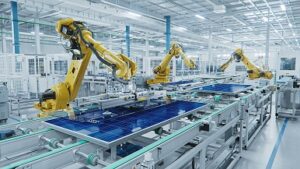Think of automation in greenhouses as the tech-savvy gardener’s secret weapon—a high-tech dance of precision that orchestrates the perfect conditions for your plants. It’s not just about controlling the temperature; it’s a symphony of environmental mastery. Picture this: technology stepping in as the ultimate plant whisperer, regulating everything from humidity to the precise dosage of nutrients. It’s a gardening dream come true!
Automated greenhouse system have got it covered with all parameters like light, water, and nutrients. Imagine a world where your plants never suffer from too much or too little of anything—they’re living their best, precisely-tailored lives.
This isn’t just about convenience; it’s about optimization. Automation isn’t a luxury; it’s the key to unlocking your greenhouse’s full potential. Forget the guesswork; let technology handle it. With automation, your greenhouse becomes a haven where plants flourish, and you get to play the role of the gardening maestro. So, why settle for anything less?
It’s A Good Package!
- Precision Control
Automated greenhouses allow precise control over environmental factors such as temperature, humidity, and lighting. This ensures optimal conditions for plant growth, leading to higher yields and better-quality crops.
- Water Efficiency
Automation systems enable smart irrigation, ensuring that plants receive the right amount of water at the right time. This not only conserves water but also prevents over-watering, reducing the risk of waterlogged soil and root diseases.
- Energy Conservation
Automated greenhouses often incorporate energy-efficient technologies, such as LED lighting and advanced climate control systems. This not only reduces energy consumption but also lowers operational costs, making greenhouse farming more sustainable.
- Enhanced Crop Monitoring
Sensors and monitoring devices installed in automated greenhouses provide real-time data on plant health and growth. Farmers can quickly identify issues such as pests or diseases, allowing for prompt intervention and preventing potential crop losses.
- Year-Round Production
Automation allows for year-round cultivation by creating an environment where seasonal limitations are overcome. This means farmers can grow crops continuously, leading to a more consistent and reliable food supply.
- Labor Savings
Automation reduces the need for manual labor in greenhouse operations. Tasks such as monitoring, irrigation, and climate control can be handled by automated systems, allowing farmers to focus on more strategic aspects of crop management.
- Optimized Resource Utilization
By precisely controlling environmental conditions, automated greenhouses optimize the use of resources such as water, fertilizers, and energy. This not only benefits the environment but also contributes to cost savings for farmers.
- Faster Crop Growth
Automated systems ensure that plants receive the ideal conditions for growth throughout their life cycle. This accelerates the growth process, allowing for quicker turnover of crops and increased productivity.
- Data-Driven Decision Making
The collection of data through automation enables farmers to make informed decisions. Analyzing trends and patterns in environmental conditions and crop performance helps in refining cultivation strategies, ultimately leading to improved overall efficiency and profitability.
Conclusion:
Maintaining fertilizer levels and managing pests in a small greenhouse garden can be challenging. Thus, the advantages of automation become even more crucial for larger commercial greenhouses. The precision, efficiency, and labor savings offered by automated systems make them an indispensable choice for ensuring optimal productivity and sustainability in extensive agricultural operations.


